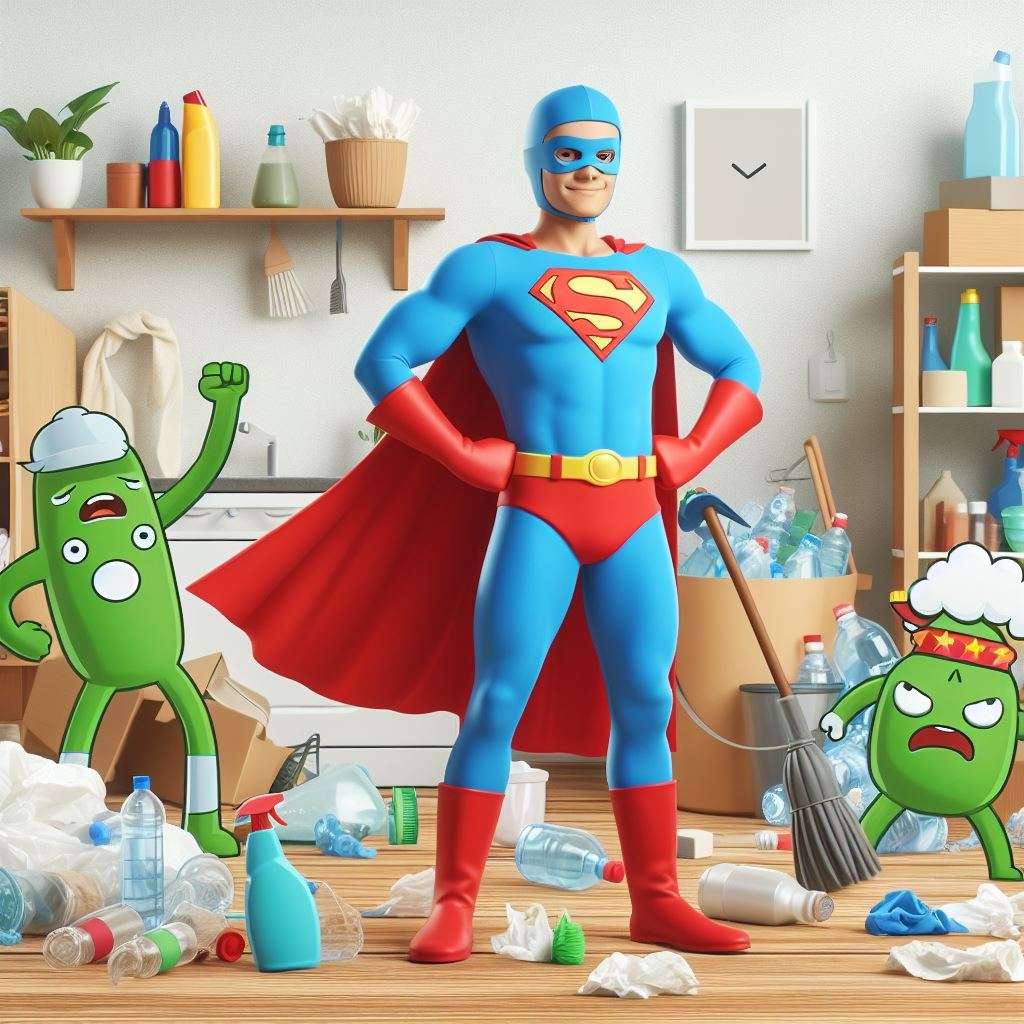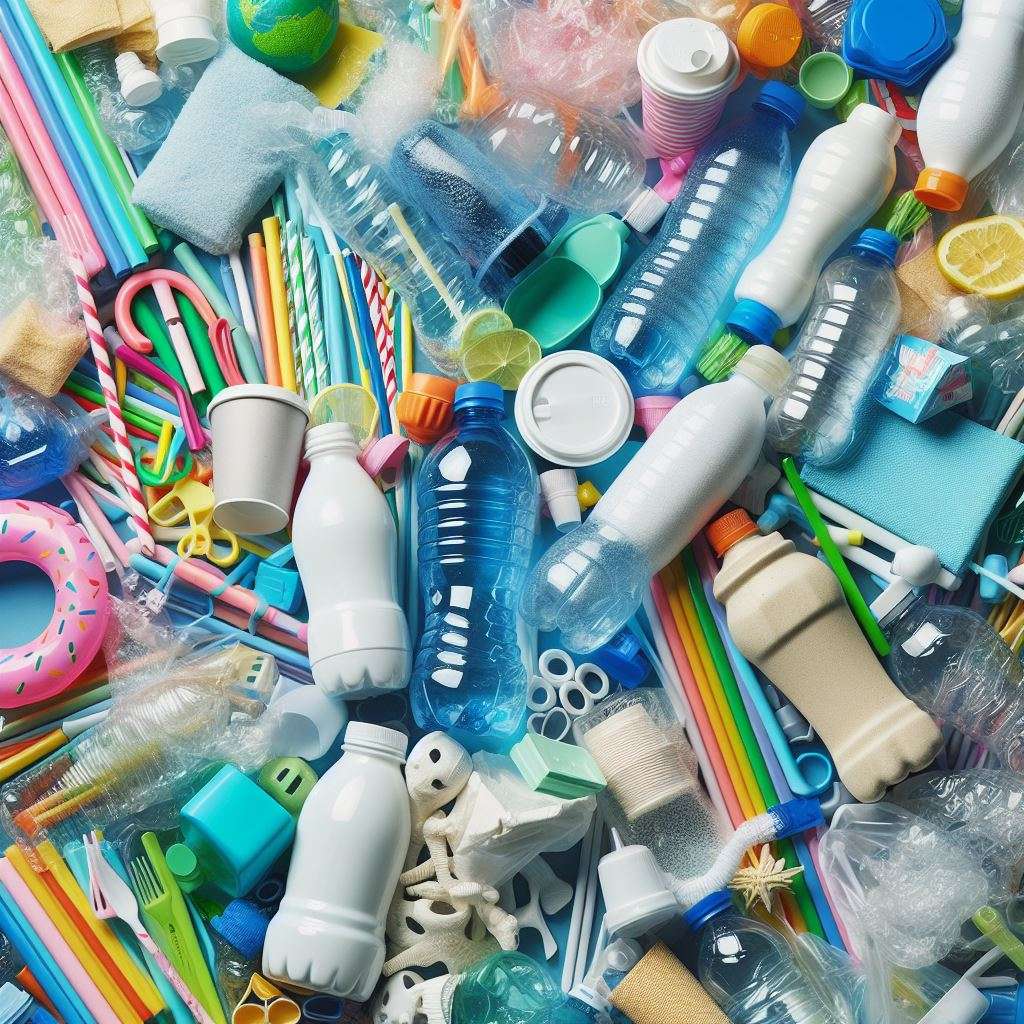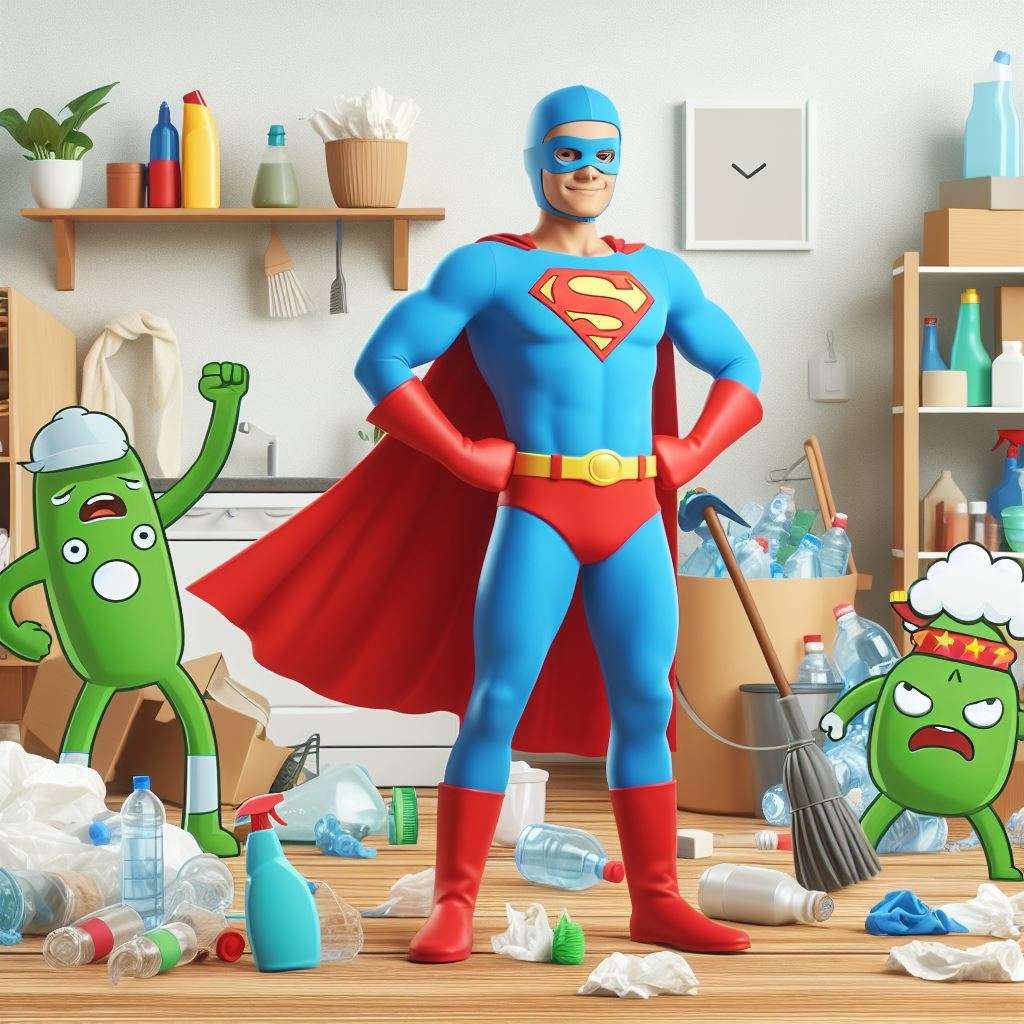Think your home is an eco-paradise? Brace yourself, heroes, because some sneaky eco-villains might be lurking in your own spaces! These are common household items that have a surprisingly high environmental impact. They may seem harmless, but they are secretly wreaking havoc on our planet. In this article, we will reveal these villains, their nefarious deeds, and the heroic ways to banish them from your home. Are you ready to take on the challenge?

Section 1: The Plastic Posse

The first four eco-villains are members of the Plastic Posse. They are plastic water bottles, cling wraps, plastic bags, and disposable straws. These are some of the most widely used and discarded items in our daily lives. But do you know what they do to the environment?
- Plastic water bottles: These are one of the biggest sources of plastic waste. According to the World Wildlife Fund, more than one million plastic bottles are sold every minute around the world. That’s a lot of plastic! Most of these bottles end up in landfills or oceans, where they take hundreds of years to decompose. They also leach harmful chemicals into the soil and water, and pose a threat to wildlife that may ingest or get entangled in them.
- Cling wrap: This is another common plastic item that we use to wrap and store food. However, cling wrap is not recyclable or biodegradable. It also contains chemicals like phthalates and BPA, which can disrupt our hormones and affect our health. Cling wrap also contributes to food waste, as it prevents us from seeing what’s inside the fridge and encourages us to buy more than we need.
- Plastic bags: These are ubiquitous in our shopping trips, but they are also very damaging to the environment. According to the Environmental Protection Agency, only 9% of plastic bags are recycled in the US. The rest end up in landfills, oceans, or littering the streets. Plastic bags can choke, suffocate, or injure animals that mistake them for food or shelter. They also break down into microplastics, which are tiny pieces of plastic that can accumulate in the food chain and harm our health.
- Disposable straws: These are another example of single-use plastic that we often use without thinking. According to the Ocean Conservancy, straws are among the top 10 items found in beach cleanups. Straws are difficult to recycle and often end up in the ocean, where they can injure or kill marine animals like turtles, fish, and birds. Straws also contain chemicals like BPA, which can leach into our drinks and affect our hormones.
How can we evict these plastic villains from our home? Here are some powerful eviction tactics:
- Reusable water bottles: Instead of buying plastic water bottles, invest in a reusable water bottle that you can fill up with tap water or filtered water. This will save you money, reduce plastic waste, and keep you hydrated. You can also choose a water bottle made of stainless steel, glass, or bamboo, which are more eco-friendly than plastic.
- Beeswax wraps: Instead of using cling wrap, try using beeswax wraps to cover and store food. Beeswax wraps are made of cotton fabric coated with beeswax, which makes them naturally antibacterial and breathable. They are also reusable, compostable, and easy to clean. You can use them to wrap sandwiches, cheese, fruits, vegetables, and more.
- Reusable cloth bags: Instead of using plastic bags, bring your own reusable cloth bags when you go shopping. Cloth bags are durable, washable, and versatile. You can use them for groceries, books, clothes, and other items. You can also make your own cloth bags from old t-shirts, pillowcases, or curtains, and personalize them with your own designs.

Metal straws: Instead of using disposable straws, switch to metal straws that you can wash and reuse. Metal straws are sturdy, stylish, and safe. They come in different sizes, shapes, and colors, and some even have silicone tips for comfort. You can also carry them in a pouch or a case when you go out, and use them for smoothies, juices, coffee, and more.
Section 2: The Chemical Clan
The next four eco-villains are members of the Chemical Clan. They are toxic cleaning chemicals, synthetic air fresheners, aerosol cans, and chemically laden laundry detergents. These are some of the products that we use to keep our home clean and fresh. But do you know what they do to the environment?
- Toxic cleaning chemicals: These are the products that we use to disinfect, degrease, and deodorize our surfaces, floors, and bathrooms. However, many of these products contain harsh chemicals like ammonia, chlorine, and formaldehyde, which can irritate our skin, eyes, and lungs. They can also pollute our water sources, as they are washed down the drain or flushed down the toilet. They can harm aquatic life, disrupt the natural balance of ecosystems, and contaminate our drinking water.
- Synthetic air fresheners: These are the products that we use to mask unpleasant odors and create a pleasant ambiance in our home. However, many of these products contain synthetic fragrances, which are made of hundreds of chemicals that are not disclosed on the label. These chemicals can release volatile organic compounds (VOCs) into the air, which can cause headaches, nausea, and allergies. They can also react with other pollutants in the air, and form ozone, which is a harmful component of smog.
- Aerosol cans: These are the products that we use to spray paint, hairspray, deodorant, and insect repellent. However, many of these products contain propellants, which are gases that help push the product out of the can. These propellants can include hydrocarbons, which are derived from fossil fuels, and chlorofluorocarbons (CFCs), which are known to deplete the ozone layer. These gases can contribute to climate change, as they trap heat in the atmosphere and increase the greenhouse effect.
- Chemically laden laundry detergents: These are the products that we use to wash our clothes, sheets, and towels. However, many of these products contain chemicals like phosphates, optical brighteners, and synthetic fragrances, which can harm our health and the environment. Phosphates can cause algal blooms, which can deplete oxygen in the water and kill fish and other aquatic life. Optical brighteners can make fabrics appear whiter, but they can also leave residues on our skin and clothes, and cause allergic reactions. Synthetic fragrances can contain harmful chemicals that can affect our hormones and nervous system.
How can we evict these chemical villains from our homes? Here are some heroic eviction methods:
- DIY natural cleaning solutions: Instead of using toxic cleaning chemicals, try making your natural cleaning solutions from ingredients that you can find in your kitchen or pantry. For example, you can use vinegar and lemon juice to disinfect and deodorize surfaces, baking soda and salt to scrub and remove stains, and olive oil and lemon juice to polish and shine wood. These solutions are effective, cheap, and safe for you and the environment.
- Essential oils for air filtration: Instead of using synthetic air fresheners, try using essential oils to purify and scent the air in your home. Essential oils are extracted from plants, and they have various benefits for your health and mood. You can use a diffuser, a spray bottle, or a cotton ball to disperse the oils in the air. You can also mix and match different oils to create your custom blends. Some of the best oils for air filtration are lavender, peppermint, eucalyptus, and tea tree.
- Refillable cleaning bottles: Instead of using aerosol cans, try using refillable cleaning bottles that you can fill with your own solutions or buy from eco-friendly brands. Refillable bottles are reusable, recyclable, and economical. They also reduce waste, as you only use what you need, and avoid throwing away empty cans. You can use refillable bottles for various purposes, such as spraying paint, applying hairspray, dispensing deodorant, and repelling insects.
- Eco-friendly laundry detergents: Instead of using chemically laden laundry detergents, try using eco-friendly laundry detergents that are made of natural or plant-based ingredients. Eco-friendly detergents are biodegradable, gentle, and effective. They also save water, as they require less rinsing and energy
- Eco-friendly laundry detergents: Instead of using chemically laden laundry detergents, try using eco-friendly laundry detergents that are made of natural or plant-based ingredients. Eco-friendly detergents are biodegradable, gentle, and effective. They also save water, as they require less rinsing, and energy, as they work well in cold water. You can buy eco-friendly detergents from various brands, or make your own from ingredients like soap nuts, baking soda, and vinegar.
- !A person happily cleans with homemade vinegar and lemon spray, surrounded by natural plants.
Section 3: The Energy Eaters
The final four eco-villains are members of the Energy Eaters. They are energy-guzzling appliances, incandescent light bulbs, standby power vampires, and leaky faucets. These are some of the items that we use to make our home comfortable and convenient. But do you know what they do to the environment?
- Energy-guzzling appliances: These are the appliances that we use to cook, clean, and entertain ourselves. However, many of these appliances consume a lot of electricity, especially if they are old, inefficient, or poorly maintained. According to the U.S. Department of Energy, the average household spends about $2,000 a year on energy bills, and about half of that goes to heating and cooling. Energy-guzzling appliances not only cost us money, but also contribute to greenhouse gas emissions, as they rely on fossil fuels to generate electricity.
- Incandescent light bulbs: These are the light bulbs that we use to illuminate our home. However, incandescent light bulbs are very inefficient, as they convert only about 10% of the energy they use into light, and the rest into heat. According to the U.S. Environmental Protection Agency, if every household in the U.S. replaced one incandescent light bulb with an ENERGY STAR certified bulb, it would save enough energy to light 3 million homes for a year, and prevent 9 billion pounds of greenhouse gas emissions.
- Standby power vampires: These are the devices that we leave plugged in or on standby mode, even when we are not using them. Examples include TVs, computers, chargers, and game consoles. These devices may seem harmless, but they actually consume a lot of electricity, even when they are not in use. According to the Natural Resources Defense Council, the average U.S. household spends about $165 a year on idle load electricity, which is equivalent to the output of 50 large power plants. Standby power vampires not only waste energy, but also increase the risk of fire and electrical shocks.
- Leaky faucets: These are the faucets that drip water, even when they are turned off. These faucets may seem insignificant, but they actually waste a lot of water, which is a precious and finite resource. According to the U.S. Geological Survey, a faucet that drips at the rate of one drop per second can waste more than 3,000 gallons of water per year. That’s enough water to take more than 180 showers. Leaky faucets not only waste water, but also increase your water bill and cause damage to your pipes and fixtures.
How can we evict these energy villains from our home? Here are some eviction tools:
- Energy-efficient appliances: Instead of using energy-guzzling appliances, try using energy-efficient appliances that are certified by ENERGY STAR or other reputable labels. Energy-efficient appliances use less electricity, perform better, and last longer than conventional appliances. They also save you money, as they reduce your energy bills and maintenance costs. You can use energy-efficient appliances for various purposes, such as refrigerating, cooking, washing, and drying.
- LED bulbs: Instead of using incandescent light bulbs, try using LED bulbs that are more efficient, durable, and versatile. LED bulbs use about 75% less energy, last about 25 times longer, and emit less heat than incandescent bulbs. They also come in different colors, shapes, and sizes, and some even have smart features that allow you to control them with your phone or voice. You can use LED bulbs for various lighting needs, such as ambient, task, and accent lighting.
- Power strips: Instead of leaving your devices plugged in or on standby mode, try using power strips that allow you to turn off multiple devices with one switch. Power strips are convenient, safe, and easy to use. They also help you save energy, as they prevent your devices from drawing electricity when they are not in use. You can use power strips for various devices, such as TVs, computers, chargers, and game consoles.
- Faucet repair kits: Instead of ignoring your leaky faucets, try fixing them with faucet repair kits that are available at most hardware stores. Faucet repair kits are inexpensive, simple, and effective. They usually contain washers, O-rings, and other parts that can stop the leaks and restore the function of your faucets. You can use faucet repair kits for various types of faucets, such as compression, cartridge, ball, and ceramic disk faucets.

Conclusion
Congratulations, heroes! You have successfully evicted the dirty dozen eco-villains from your home, and created a greener and cleaner space. You have also saved money, energy, and water, and reduced your environmental footprint. You should be proud of your achievements, and share them with your friends and family. You never know, you might inspire them to join the fight against eco-villains and make a difference in the world.
But don’t rest on your laurels, heroes. There are still more eco-villains out there, waiting to sneak into your home and sabotage your efforts. You have to remain vigilant and keep looking for ways to improve your home and lifestyle. Remember, every little action counts, and every evicted villain matters. Together, we can build a sustainable future, one evicted villain at a time!
Further Reading
- Green Up Your Life: Simple Swaps for Sustainable Smiles
- Upcycled or recycled products: Choose items made from repurposed materials to reduce waste and support creative artisans
- Reusable Straws: Skip the Plastic Straw and Carry Your Own Metal or Bamboo Straw When Enjoying Drinks on the Go
- The Environmental Benefits of Choosing Eco-Friendly Products
- Top 10 reasons why we need to use eco friendly Products
